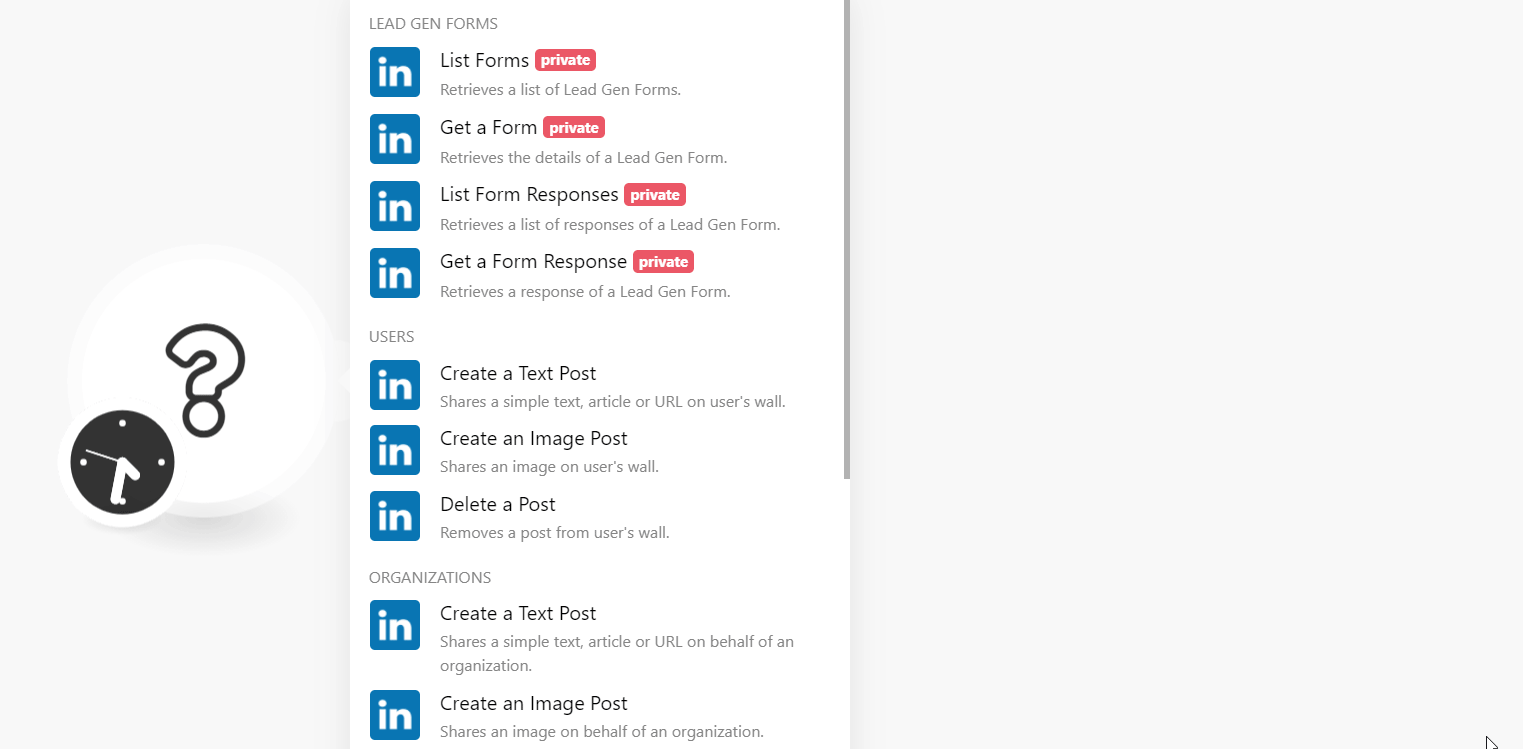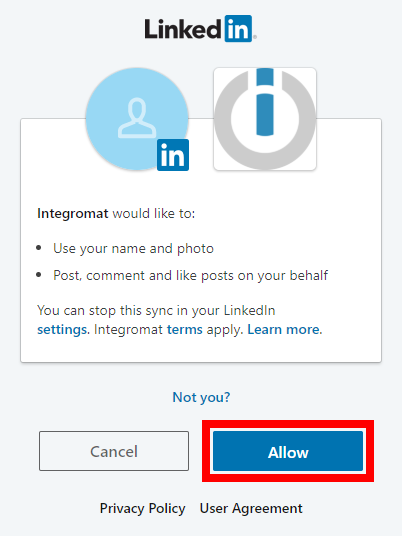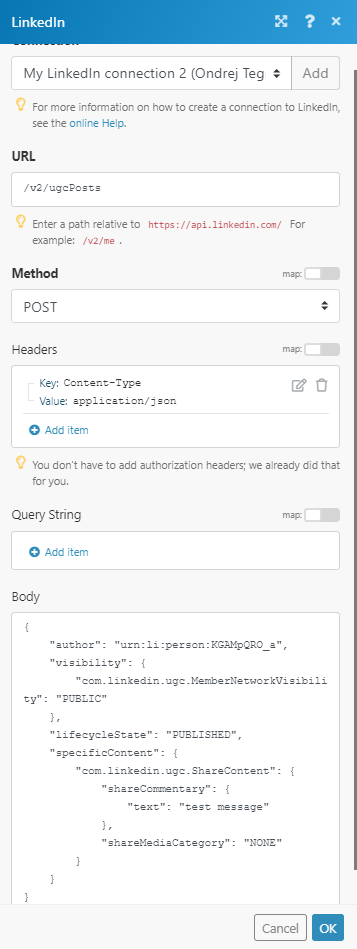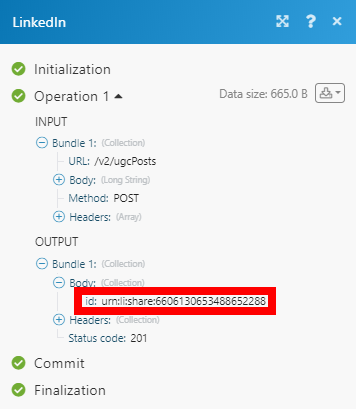LinkedIn¶
Caution
Please upgrade your scenarios that contain old LinkedIn modules to the current version of the LinkedIn modules. As of May 1, 2019, the old version is no longer supported and may stop working anytime.
The LinkedIn modules enable you to monitor, create and delete posts on a user's wall or create and delete posts on behalf of an organization, create, update, list, retrieve, and delete the lead gen forms, and form responses in your LinkedIn account.
Getting Started with LinkedIn¶
Prerequisites
- A LinkedIn account - create an account at linkedin.com/signup
Note
The module dialog fields that are displayed in bold (in the Ibexa Connect scenario, not in this documentation article) are mandatory!
Connecting LinkedIn to Ibexa Connect¶
-
Go to Ibexa Connect and open the LinkedIn module's Create a connection dialog and click Continue.

-
Confirm the access by clicking Allow.

The connection has been established.
Lead Gen Forms¶
Watch Form Responses¶
Triggers when a Lead Gen Form is submitted.
Required Permissions: r_ads, r_ads_leadgen_automation
This webhook is an instant trigger ideal for normal users to receive a response when a member submits a form. For more information, see Instant Triggers.Instant triggers (webhooks)
You do not have to add the webhooks in LinkedIn as it is automatically done for you once you add and save an instant trigger module to your scenario.
| Webhook Name | Enter (map) a webhook name. |
| Ad Account URN | Select or map the account URN whose campaign form responses you want to watch. |
Watch Form Responses¶
Triggers when a Lead Gen Form is submitted.
Required Permissions: r_ads, r_ads_leadgen_automation
This module is a general trigger to watch and trigger an alert to the user when a form response is received based on the specified filters in the module. For more information, see Webhooks.
| Ad Account URN | Select or map the account URN whose campaign form responses you want to watch. |
| Campaign URN | Select or map the campaign associated with the form |
| Creative URN | Enter (map) the Creative URN associated with the form. |
| Fields | Enter (map) the fields you want to watch in the form response. For more information, see Fields Projection. |
| Projection | Enter (map) the projections you want to watch in the form response. For more information, see Response Decoration. |
| Limit | Set the maximum number of form responses Ibexa Connect should return during one execution cycle. |
List Forms¶
Retrieves a list of Lead Gen Forms.
Required Permissions: r_ads, r_ads_leadgen_automation
| Ad Account URN | Select or map the ad account URN whose lead gen forms you want to list. |
| Limit | Set the maximum number of lead gen forms Ibexa Connect should return during one execution cycle. |
Get a Form¶
Retrieves the details of a Lead Gen Form.
Required Permissions: r_ads, r_ads_leadgen_automation
| Form ID or URN | Select or map the Form ID or URN whose details you want to retrieve. |
List Form Responses¶
Retrieves a list of responses of a Lead Gen Form.
Required Permissions: r_ads, r_ads_leadgen_automation
| Ad Account URN | Enter a keyword or phrase to search and list the form responses that match the specified query. |
| Form URN | Enter (map) the Form ID or URN whose responses you want to list. |
| Campaign URN | Enter (map) the campaign URN to which the form belongs. |
| Creative URN | Enter (map) the creative URN associated with the form whose responses you want to list. |
| Start Time | Enter (map) the date and time to list the form responses created on or after the specified time. |
| End Time | Enter (map) the date and time to list the form responses created on or before the specified time. |
| Limit | Set the maximum number of form responses Ibexa Connect should return during one scenario execution cycle. |
Get a Form Response¶
Retrieves a response of a Lead Gen Form.
Required Permissions: r_ads, r_ads_leadgen_automation
| Ad Account URN | Select or map the account URN whose form response details you want to retrieve. |
| Response ID or URN | Enter (map) the Response ID or URN whose details you want to retrieve. |
Update a Form Status¶
Updates the status of a Lead Gen Form by its ID.
Required Permissions: r_ads, r_ads_leadgen_automation
Form ID or URN |
Select or map the Form ID or URN whose status you want to update. |
Status |
Select or map the status you want to update for the form:
|
Get a Form Question¶
Retrieves the details of a question of a Lead Gen Form by its ID.
| Form ID or URN | Select or map the Form ID or URN whose question details you want to retrieve. |
| Question ID | Enter (map) the Question ID whose details you want to retrieve. |
Create a Form¶
Creates a new Lead Gen Form.
Required Permissions: rw_ads, r_ads, r_ads_leadgen_automation
Ad Account URN |
Select or map the ad account URN for which you want to create the form. |
||||||||
Language |
Select or map the language of the form. |
||||||||
Name |
Enter (map) the form name. The form is visible to the owner of the form but not visible to the viewer. |
||||||||
Headline |
Enter (map) the form headline. |
||||||||
Privacy Policy URL |
Enter (map) the privacy policy URL that covers any data passed to the owner of the form. |
||||||||
Lead Profile Information |
Select or map the lead profiles for whom the form is targeted to. |
||||||||
Custom Questions |
Add the questions targeted for the lead profiles.
A maximum of 12 questions is allowed. |
||||||||
Descriptions |
Enter (map) the details of the form. A maximum of 160 characters is allowed. |
||||||||
Legal Disclaimer |
Enter (map) the disclaimer text that appears on the form. A maximum of 2000 characters is allowed. |
||||||||
Custom Checkboxes |
Add the custom checkboxes for the form: Content Add the content of the checkbox fields. A maximum of 500 characters is allowed. Consent Required Select the checkbox if consent is required to display the custom checkbox. |
||||||||
Thank You Message |
Enter (map) the message displayed to a member after the form is submitted. The maximum number of characters allowed is 300 characters. |
||||||||
Landing Page URL |
Enter (map) the form URL address. |
||||||||
Thank You Message Call-to-action |
Enter (map) the message displayed on the call-to-action button. You can set one of the following values:
| This message appears as text on the button. The URL is controlled by the |
Hidden Fields
Add the hidden fields for the form.
Name
Enter (map) the field name
Value
Enter (map) the field value.
Note
You can add up to 20 fields.
Update a Form¶
Updates an existing Lead Gen Form by its ID.
Required Permissions: rw_ads, r_ads, r_ads_leadgen_automation
Form ID or URN |
Select or map the Form ID or URN whose details you want to update. |
||||||||
Name |
Enter (map) the form name. The form is visible to the owner of the form but not visible to the viewer. |
||||||||
Headline |
Enter (map) the form headline. |
||||||||
Privacy Policy URL |
Enter (map) the privacy policy URL that covers any data passed to the owner of the form. |
||||||||
Lead Profile Information |
Select or map the lead profiles for whom the form is targeted to. |
||||||||
Custom Questions |
Add the questions targeted for the lead profiles.
A maximum of 12 questions is allowed. |
||||||||
Descriptions |
Enter (map) the details of the form. A maximum of 160 characters is allowed. |
||||||||
Legal Disclaimer |
Enter (map) the disclaimer text that appears on the form. A maximum of 2000 characters is allowed. |
||||||||
Custom Checkboxes |
Add the custom checkboxes for the form: Content Add the content of the checkbox fields. A maximum of 500 characters is allowed. Consent Required Select the checkbox if consent is required to display the custom checkbox. |
||||||||
Thank You Message |
Enter (map) the message displayed to a member after the form is submitted. The maximum number of characters allowed is 300 characters. |
||||||||
Landing Page URL |
Enter (map) the form URL address. |
||||||||
Thank You Message Call-to-action |
Enter (map) the message displayed on the call-to-action button. You can set one of the following values:
| This message appears as text on the button. The URL is controlled by the |
Hidden Fields
Add the hidden fields for the form.
Name
Enter (map) the field name
Value
Enter (map) the field value.
Note
You can add up to 20 fields.
Users¶
Create a Text Post¶
Shares a simple text, article, or URL on the user's wall.
Required Permissions: w_member_social
Content |
Enter the text content of the post. |
Type |
Select whether to post simple text or link. |
Link |
|
Create an Image Post¶
Shares an image post on the user's wall.
Required Permissions: w_member_social
Source File |
Map the file you want to upload from the previous module (For example, HTTP > Get a File or Dropbox > Get a file), or enter the file name and file data manually.
|
Title |
Enter the title for the image post. |
Description |
Enter the description for the post. |
Content |
Enter the text content shared with the image. |
Delete a Post¶
Removes a post from the user's wall.
Required Permissions: w_member_social
| Post ID | Enter (map) the ID of the post you want to delete. |
Organizations¶
Create a Text Post¶
Shares a simple text, article, or URL on behalf of an organization.
Required Permissions: rw_organization_admin, w_organization_social
Note
You may need to extend Ibexa Connect permissions for LinkedIn access.
Organization |
Select the organization you want to create a post on behalf of. |
Content |
Enter the text content of the post. |
Type |
Select whether to post simple text or link. |
Link |
|
Create an Image Post¶
Shares an image post on behalf of an organization.
Required Permissions: rw_organization_admin, w_organization_social
Organization |
Select the organization you want to create a post on behalf of. |
Source File |
Map the file you want to upload from the previous module (For example, HTTP > Get a File or Dropbox > Get a file), or enter the file name and file data manually.
|
Title |
Enter the title for the image post. |
Description |
Enter the description for the post. |
Content |
Enter the text content shared with the image. |
Search for Organizations¶
Finds organizations by the vanity name or email domain.
Find Organization By |
Select the option you want to search organizations by.
|
Limit |
Set the maximum number of organizations Ibexa Connect will return during one execution cycle. |
Other¶
Make an API Call¶
Allows you to perform a custom API call.
Note
Retrieving LinkedIn posts is not available at the moment.
URL |
Enter a path relative to | For the list of available endpoints, refer to the LinkedIn API Documentation. |
Method
Select the HTTP method you want to use:
GET to retrieve information for an entry.
POST to create a new entry.
PUT to update/replace an existing entry.
PATCH to make a partial entry update.
DELETE to delete an entry.
Headers
Enter the desired request headers. You don't have to add authorization headers; we already did that for you.
Query String
Enter the request query string.
Body
Enter the body content for your API call.
Example of Use - Create a Post¶
The following API call creates a user post in your LinkedIn account:
URL: /v2/ugcPosts
Method: POST
Body:
1 2 3 4 5 6 7 8 9 10 11 12 13 14 15 | |

The result can be found in the module's Output under Bundle > Body.
In our example, the post ID was returned (and the post on the user's wall was created):
